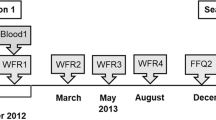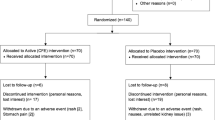Abstract
Objective: To study serum quercetin concentrations of subjects consuming berries or habitual Finnish diets.
Design: Randomized parallel dietary intervention.
Subjects: Forty healthy men (age 60 y).
Intervention: Twenty subjects consumed 100 g/day of berries (black currants, lingonberries and bilberries) for 8 weeks. Twenty subjects consuming their habitual diets served as controls. Fasting blood samples were obtained 2 weeks prior to the study, at baseline, and at 2, 4 and 8 weeks. Intake of quercetin was assessed from 3 day food records collected at baseline and at 8 weeks.
Results: The serum quercetin concentrations were significantly higher in the subjects consuming berries compared to the control group (P=0.039 ANCOVA with repeated measures). During the berry consumption period the mean serum concentrations of quercetin ranged between 21.4 and 25.3 µg/l in the berry group, which was 32–51% higher compared with the control group. According to 3 day food records, there was no difference in quercetin intake at baseline, but at 8 weeks the intake was 12.3±1.4 mg/day (mean±s.e.m.) in the berry group and 5.8±0.6 mg/day in the control group (P=0.001).
Conclusion: The results indicate that the berries used in this study are a good source of bioavailable quercetin.
Sponsorship: The study was supported by the Academy of Finland, Juho Vainio Foundation and the Finnish Foundation for Cardiovascular Research.
This is a preview of subscription content, access via your institution
Access options
Subscribe to this journal
Receive 12 print issues and online access
$259.00 per year
only $21.58 per issue
Buy this article
- Purchase on Springer Link
- Instant access to full article PDF
Prices may be subject to local taxes which are calculated during checkout

Similar content being viewed by others
References
Aviram, M & Fuhrman, B (1998). Polyphenolic flavonoids inhibit macrophage-mediated oxidation of LDL and attenuate atherogenesis. Atherosclerosis, 137, (Suppl) S45–50.
Caltagirone, S, Ranelletti, FO, Rinelli, A, Maggiano, N, Colasante, A, Musiani, P, Aiello, FB & Piantelli, M (1997). Interaction with type II estrogen binding sites and antiproliferative activity of tamoxifen and quercetin in human non-small-cell lung cancer. Am. J. Respir. Cell Mol. Biol., 17, 51–59.
Chopra, M, Fitzsimons, PE, Strain, JJ, Thurnham, DI & Howard, AN (2000). Nonalcoholic red wine extract and quercetin inhibit LDL oxidation without affecting plasma antioxidant vitamin and carotenoid concentrations. Clin. Chem., 46, 1162–1170.
de Vries, JH, Hollman, PC, van Amersfoort, I, Olthof, MR & Katan, MB (2001). Red wine is a poor source of bioavailable flavonols in men. J. Nutr., 131, 745–748.
Erlund, I, Alfthan, G, Siren, H, Ariniemi, K & Aro, A (1999). Validated method for the quantitation of quercetin from human plasma using HPLC with electrochemical detection. J. Chromatogr. B Biomed. Applic., 727, 179–189.
Erlund, I, Kosonen, T, Alfthan, G, Mäenpää, J, Perttunen, K, Kenraali, J, Parantainen, J & Aro, A (2000). Pharmacokinetics of quercetin from quercetin aglycone and rutin in healthy volunteers. Eur. J. Clin. Pharmac., 56, 545–553.
Erlund, I, Alfthan, G, Mäenpää, J & Aro, A (2001). Tea and coronary heart disease: the flavonoid quercetin is more bioavailable from rutin in women than in men. Arch. Intern. Med., 161, 1919–1920.
Erlund, I, Silaste, ML, Alfthan, G, Rantala, M, Kesäniemi, YA & Aro, A (2002). Plasma concentrations of the flavonoids naringenin, hesperetin and quercetin in human subjects following their habitual diets, or diets high or low in fruits and vegetables. Eur. J. Clin. Nutr., (in press)
Freese, R, Alfthan, G, Jauhiainen, M, Basu, S, Erlund, I, Salminen, I, Aro, A & Mutanen, M (2002). High intake of vegetables, berries and apple combined with high intake of linoleic or oleic acid only slightly affects markers of lipid peroxidation and lipoprotein metabolism in healthy subjects. Am. J. Clin. Nutr., (in press)
Hakala, P, Marniemi, J, Knuts, L-R, Kumpulainen, J, Tahvonen, R & Plaami, S (1996). Calculated vs. analysed nutrient composition of weight reduction diets. Food Chem., 57, 71–75.
Häkkinen, S & Auriola, S (1998). High-performance liquid chromatography with electrospray ionization mass spectrometry and diode array ultraviolet detection in the identification of flavonol aglycones and glycosides in berries. J. Chromatogr. A., 829, 91–100.
Häkkinen, SH, Kärenlampi, SO, Heinonen, IM, Mykkänen, HM & Törrönen, AR (1999). Content of the flavonols quercetin, myricetin, and kaempferol in 25 edible berries. J. Agric. Food Chem., 47, 2274–2279.
Häkkinen, S (2000). Flavonols and phenolic acids in berries and berry products (dissertation). Kuopio: University of Kuopio
Hertog, MGL, Kromhout, D, Aravanis, C, Blackburn, H, Buzina, R & Fidanza, F et al (1995). Flavonoid intake and long-term risk of coronary heart disease and cancer in the Seven Countries Study. Arch. Intern. Med., 155, 381–386.
Hirvonen, T (2001). Flavonol and flavone intake and risk of cardiovascular disease and cancer in male smokers (dissertation). Helsinki: Publications of the National Public Health Institute (KTL) A19/2001
Hollman, PC, van Trijp, JM, Buysman, MN, van der Gaag, MS, Mengelers, MJ, de Vries, J & Katan, MB (1997). Relative bioavailability of the antioxidant flavonoid quercetin from various foods in man. FEBS Lett., 418, 152–156.
Hollman, PC, Van Het Hof, KH, Tijburg, LB & Katan, MB (2001). Addition of milk does not affect the absorption of flavonols from tea in man. Free Radic. Res., 34, 297–300.
Johansson, L, Becker, W, Fagt, S, porgeirsdóttir, H & Valsta, L (1998). Grønnsak-og fruktinntakket i Norden (in Norwegian), Uppsala: Nordiska Ministerrådet
Kleemola, P, Virtanen, M & Pietinen, P (1994). The 1992 dietary survey of Finnish adults, Helsinki: Publications of the National Public Health Institute B2/1994
Knekt, P, Jarvinen, R, Reunanen, A & Maatela, J (1996). Flavonoid intake and coronary mortality in Finland: a cohort study. Br. Med. J., 312, 478–481.
Knuts, L-R, Rastas, M, Haapala, P, Seppänen, R, Karvetti, R-L & Aro, A (1987). Nutrica–a computer program for calculation of food and nutrient intake. Abstracts of the Third Meeting of Eurofoods, Warsaw, 24–27 May 1987, p16
Koeppen, BH & Herrmann, K (1977). Flavonoid glycosides and hydroxycinnamic acid esters of blackcurrants (Ribes nigrum). Phenolics of fruits 9. Z Lebensm Unters Forsch., 164, 263–268.
Kühnau, J (1976). The flavonoids. A class of semi-essential food components: their role in human nutrition. World Rev. Nutr. Diet, 24, 117–191.
Ludden, TM (1991). Nonlinear pharmocokinetics. Clinical implications. Clin. Pharmacokinet., 20, 429–446.
Marniemi, J, Hakala, P, Mäki, J & Ahotupa, M (2000). Partial resistance of low density lipoprotein to oxidation in vivo after increased intake of berries. Nutr. Metab. Cardiovasc. Dis., 10, 331–337.
Mattila, P, Astola, J & Kumpulainen, J (2000). Determination of flavonoids in plant material by HPLC with diode-array and electro-array detections. J. Agric. Food Chem., 48, 5834–5841.
Mikkonen, TP, Määttä, KR, Hukkanen, AT, Kokko, HI, Törrönen, AR, Kärenlampi, SO & Karjalainen, RO (2001). Flavonol content varies among black currant cultivars. J. Agric. Food Chem., 49, 3274–3277.
Murkovic, M, Adam, U & Pfannhauser, W (2000). Analysis of anthocyane glycosides in human serum. Fresenius J. Anal. Chem., 366, 379–381.
Noroozi, M, Burns, J, Crozier, A, Kelly, IE & Lean, ME (2000). Prediction of dietary flavonol consumption from fasting plasma concentration or urinary excretion. Eur. J. Clin. Nutr., 54, 143–149.
Peet, GW & Li, J (1999). IkappaB kinases alpha and beta show a random sequential kinetic mechanism and are inhibited by staurosporine and quercetin. J. Biol. Chem., 274, 32655–32661.
Pereira, MA, Grubbs, CJ, Barnes, LH, Li, H, Olson, GR, Eto, I, Juliana, M, Whitaker, LM, Kelloff, GJ, Steele, VE & Lubet, RA (1996). Effects of the phytochemicals, curcumin and quercetin, upon azoxymethane-induced colon cancer and 7, 12-dimethylbenz[a]anthracene-induced mammary cancer in rats. Carcinogenesis, 17, 1305–1311.
Siess, MH, Leclerc, J, Canivenc-Lavier, MC, Rat, P & Suschetet, M (1995). Heterogenous effects of natural flavonoids on monooxygenase activities in human and rat liver microsomes. Toxicol. Appl. Pharmac., 130, 73–78.
Yochum, L, Kushi, LH, Meyer, K & Folsom, AR (1999). Dietary flavonoid intake and risk of cardiovascular disease in postmenopausal women. Am. J. Epidemiol., 149, 943–949.
Acknowledgements
We would like to thank Dr M-L Ovaskainen for providing data on quercetin concentrations of foods and for calculating berry consumption in the 1992 Dietary Survey of Finnish Adults.
Author information
Authors and Affiliations
Corresponding author
Rights and permissions
About this article
Cite this article
Erlund, I., Marniemi, J., Hakala, P. et al. Consumption of black currants, lingonberries and bilberries increases serum quercetin concentrations. Eur J Clin Nutr 57, 37–42 (2003). https://doi.org/10.1038/sj.ejcn.1601513
Received:
Revised:
Accepted:
Published:
Issue Date:
DOI: https://doi.org/10.1038/sj.ejcn.1601513
Keywords
This article is cited by
-
Food intake biomarkers for berries and grapes
Genes & Nutrition (2020)
-
An insight into the potentially old-wonder molecule—quercetin: the perspectives in foresee
Chinese Journal of Integrative Medicine (2015)
-
A bilberry drink with fermented oatmeal decreases postprandial insulin demand in young healthy adults
Nutrition Journal (2011)
-
Dietary inhibitors of monoamine oxidase A
Journal of Neural Transmission (2011)
-
Berry meals and risk factors associated with metabolic syndrome
European Journal of Clinical Nutrition (2010)



